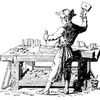Folks
Anyone here or anyone know of someone who can translate lofting dimensions into something recognizable? I’m working on an 19Th C notebook that contains sets of lofting dimensions for a schooner rigged ship and I have no clue how to interpret them.
Gary
















Replies
I could help you. If you have scans you could send them to me so I could see.
In general however, the dimensions are typically given in feet-inches-eighths. 3-4-7 would be read as 3'4-7/8". It might be on a vessel that size that they wouldn't have gone to that high of a resolution.
The numbers are probably in tabular form. The numbers across the top are stations. These are distances along the centerline. Then there would be half breadths--distances horizontally from the centerline at each station for each waterline which are horizontal slices through the hull.
One thing to consider when looking at a table of offsets--the numbers used to specify hull dimensions--is that the numbers are to the nearest eighth of an inch or whatever the smallest unit is. Using them to create a hull involves laying the points out (lofting) and then fairing the curve by bending a batten around the points and making adjustments as needed.
If you are planning to loft the hull, you might want to get a book on lofting. the WoodenBoat Store offers a number of excellent books on lofting boats.
Dave
DaveThanks, that does explain a lot. As it turns out, a goodly part of the book is a log book of time spent on the schooner and a local house. Plus price lists for supplies, including a set of tools. I'll be sharpening up the scans so I can better make out the details, particularly what look to be some notes on lofting. But I could be wrong on that account too as the print is fairly faint at this point.GaryGary Roberts
Dedham, MA USA
http://www.toolemera.com
http://toolemera.blogspot.com/
Gary
You are right up the road from a mother lode of information on lofting and schooner records: Mystic Seaport. A few years back during the launching of the Almstaad, I had a few days hold over and some time to sit down and examine records of some very impressive projects. I'm fairly certain that you could get lots of help with research and guidance on practical applications from someone at the museum or they could direct you to a person with expertise on the subject. As DR mentioned, Woodenboat's school is a great place to start out if you want to put some planks on the ribs.
The information you have here is very good -- just keep building on it. I would offer some advice but I have never gone bigger than wherries, guideboats and dories. Just don't have the space.
dan
Even better, I have a friend who is an avid sailor. Mystic, while geographically in New England, is a good long drive for me, much too long unfortunately. But as a Librarian, I'll be contacting their library reference desk to get some help. Good suggestion which slipped right by me.GaryGary Roberts
Dedham, MA USA
http://www.toolemera.com
http://toolemera.blogspot.com/
Gary,
If you are looking for information about lofting closer to home here are three sources:
Essex Shipbuilding Museum in Essex, Mass. It is on the grounds of the old A.D. Story Shipyard and is adjacent to Harold Burnham's yard where they are still turning out traditionally built wooden boats. The vessel I am captain of was lofted and built on those very grounds.
Don't overlook MIT and the hart nautical collection.
Or run up to Gloucester and visit Geno in his Dory Shop right next to the Gloucester Maritime Heritage Center.
Good Luck,
Jonathan
JonathanThat's one big Duh for me. I work at one of the MIT libraries, albeit one of the way off-campus spots. I'll link into the DB there and see what I can come up with.Thanks
GaryGary Roberts
Dedham, MA USA
http://www.toolemera.com
http://toolemera.blogspot.com/
This may help http://eweandme.com/boatblog/index.php/2007/09/
Great blog. I'll have to read the whole thing and add it at my site too. Every time you turn around there's another good blog out there.Thanks
GaryGary Roberts
Dedham, MA USA
http://www.toolemera.com
http://toolemera.blogspot.com/
NP
That is awesome. The photos and the thoughts are just great. I'd like to see more information and photos as the project moves along. What a beautiful hull. I can smell the cedar, see the planes trimming the strakes for the beautiful carvel hull. I sure wish I had the space and a group of woodworkers in my area that would commit to doing a group project. I spent a week working with a group of guys building a dory. I can't say which part I liked best? the building or the camaraderie??
As a furniture/riflebuilder/chairmaker, I tend to be a loner. Working on a hull is different -its like being on a dance floor-- you just have to stay in synch with your partner and be aware of the other dancers. I loved it and hope to do it again.
To any other readers out there that might consider doing something very different, a small boatbuilding course is a great adventure. I can't remember feeling as happy as I felt the day I got under way in my first wooden Adirondack Guideboat with all of the doubters watching as I pulled away on Lake George, NY. Nothing like it .. really.. you just glide away and the doubters stay right where they should... on the shoreline making comments. At last -- you don't have to listen to the !@#$# .. you're gone.
dan
This forum post is now archived. Commenting has been disabled